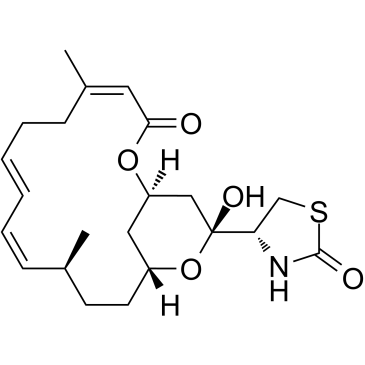Latrunculin A

Latrunculin A structure
|
Common Name | Latrunculin A | ||
|---|---|---|---|---|
| CAS Number | 76343-93-6 | Molecular Weight | 421.550 | |
| Density | 1.2±0.1 g/cm3 | Boiling Point | N/A | |
| Molecular Formula | C22H31NO5S | Melting Point | N/A | |
| MSDS | Chinese USA | Flash Point | N/A | |
|
Inhibitory mechanism of FAT4 gene expression in response to actin dynamics during Src-induced carcinogenesis.
PLoS ONE 10(2) , e0118336, (2015) Oncogenic transformation is characterized by morphological changes resulting from alterations in actin dynamics and adhesive activities. Emerging evidence suggests that the protocadherin FAT4 acts as a tumor suppressor in humans, and reduced FAT4 gene express... |
|
|
Ca(2+) permeation and/or binding to CaV1.1 fine-tunes skeletal muscle Ca(2+) signaling to sustain muscle function.
Skelet. Muscle 5 , 4, (2015) Ca(2+) influx through CaV1.1 is not required for skeletal muscle excitation-contraction coupling, but whether Ca(2+) permeation through CaV1.1 during sustained muscle activity plays a functional role in mammalian skeletal muscle has not been assessed.We gener... |
|
|
Activation of the pleiotropic drug resistance pathway can promote mitochondrial DNA retention by fusion-defective mitochondria in Saccharomyces cerevisiae.
G3 (Bethesda) 4(7) , 1247-58, (2014) Genetic and microscopic approaches using Saccharomyces cerevisiae have identified many proteins that play a role in mitochondrial dynamics, but it is possible that other proteins and pathways that play a role in mitochondrial division and fusion remain to be ... |
|
|
A novel receptor cross-talk between the ATP receptor P2Y2 and formyl peptide receptors reactivates desensitized neutrophils to produce superoxide
Exp. Cell Res. 323(1) , 209-17, (2014) Neutrophils express several G-protein coupled receptors (GPCRs) and they cross regulate each other. We described a novel cross-talk mechanism in neutrophils, by which signals generated by the receptor for ATP (P2Y2) reactivate desensitized formyl peptide rece... |
|
|
A small molecule with anticancer and antimetastatic activities induces rapid mitochondrial-associated necrosis in breast cancer.
J. Pharmacol. Exp. Ther. 353(2) , 392-404, (2015) Therapy for treatment-resistant breast cancer provides limited options and the response rates are low. Therefore, the development of therapies with alternative chemotherapeutic strategies is necessary. AG311 (5-[(4-methylphenyl)thio]-9H-pyrimido[4,5-b]indole-... |
|
|
Protrusive waves guide 3D cell migration along nanofibers.
J. Cell Biol. 211 , 683-701, (2015) In vivo, cells migrate on complex three-dimensional (3D) fibrous matrices, which has made investigation of the key molecular and physical mechanisms that drive cell migration difficult. Using reductionist approaches based on 3D electrospun fibers, we report f... |
|
|
CFP-10 from Mycobacterium tuberculosis selectively activates human neutrophils through a pertussis toxin-sensitive chemotactic receptor.
Infect. Immun. 83(1) , 205-13, (2014) Upon infection with Mycobacterium tuberculosis, neutrophils are massively recruited to the lungs, but the role of these cells in combating the infection is poorly understood. Through a type VII secretion system, M. tuberculosis releases a heterodimeric protei... |
|
|
P2Y2 receptor signaling in neutrophils is regulated from inside by a novel cytoskeleton-dependent mechanism.
Exp. Cell Res. 336 , 242-52, (2015) Functional selectivity, a process by which G-protein coupled receptors (GPCRs) can activate one signaling route while avoiding another, is regulated by ligand-mediated stabilization of specific receptor states that modulate different downstream signaling even... |
|
|
CD19 and BAFF-R can signal to promote B-cell survival in the absence of Syk.
EMBO J. 34(7) , 925-39, (2015) The development and function of B lymphocytes is regulated by numerous signaling pathways, some emanating from the B-cell antigen receptor (BCR). The spleen tyrosine kinase (Syk) plays a central role in the activation of the BCR, but less is known about its c... |
|
|
A huntingtin-mediated fast stress response halting endosomal trafficking is defective in Huntington's disease.
Hum. Mol. Genet. 24(2) , 450-62, (2014) Cellular stress is a normal part of the aging process and is especially relevant in neurodegenerative disease. Canonical stress responses, such as the heat shock response, activate following exposure to stress and restore proteostasis through the action of is... |